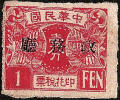 |
||||||||
|
Forerunners Mukden Opium Destroy Certificates
Regional Issues
Manchukuo Manchukuo Marriage Registration Tax
Harbin & Mukden Municipal Revenues
Kwantung
|
|
|||||||
|
.First Regular Issue of Manchukuo Revenue Stamps Issued 25th October 1932. This is the first general issue of Manchukuo revenue stamps, (shown below). They are based upon the "Republic of China" 1931 regular issue in terms of layout and feature soya beans, with the four character banner at the top changed to read "Great Manchukuo". The set has eight values from 1 fen to 10 Yuan. Some books state that the elusive 2Y stamp was not issued until 1933 however this is not the case. You will see the copy below is dated 5th September 1932 and I have also seen other examples including as part of a set overprinted 樣本 sample in violet.
The top panel reads -
大滿州國
Great Manchukuo (this form was only used
in 1932 and early 1933)
Litho printed on white un-watermarked paper, Size 23mm x 18.5mm. Perf 13½
x 13. Designer and printer unknown.
|
||||||||
 |
 |
 |
 |
 |
||||
 |
 |
 |
||||||
| Rare | ||||||||
| Court Cancel | ||||||||
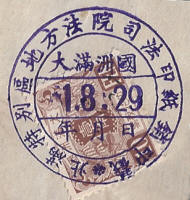 |
||||||||
| The large circular cancel above indicates that the stamp had a judicial use; payment of court fees and fines. Unlike the rest of China, Manchukuo did not use a special documentary Tax stamp in its courts. | ||||||||
| Control Chops | ||||||||
| It is thought that in 1933 towns in Manchukuo added control chops to these stamps (as was common on earlier Great Wall revenue stamps). Designs differed and could appear in violet, black or red, it is not known how many towns overprinted stamps in this way. Such overprints are rare. | ||||||||
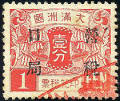
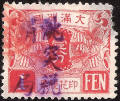 |
||||||||
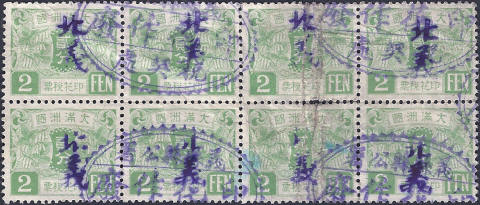 |
||||||||
|
In the first instance the upper characters read Ying-k'ou and the lower characters 局稅 (tax bureau), in the second example 局稅 is clear but the town name is unreadable. The block of 8 x 2f stamps has the control chop 北義 Pei-I (now 北义 Bei-yi). |
||||||||
| South Chahar Use | ||||||||
|
Above is a rare example of a revenue using the design of issue, note that the top panel contains 中華民國 Chinese Republic.. The black control chop reads 政務廳 "Governmental Affairs Bureau", used in Chahar. First issued December 1937 and based upon the Manchukuo design. |
||||||||
| First issue revenue stamps are hard to find on paper but a couple of examples can be seen here. | ||||||||
|
|
||||||||
|
Second Regular Issue of Manchukuo Revenue Stamps Issued 31st July 1934. These stamps feature typical scenes associated with Manchukuo including a Kaoliang motif to the boarders and two crossed Manchukuo flags in the foreground. Chinese revenue stamps often feature wheat in the left and right borders, in Manchukuo this was changed for Kaoliang (Chinese Millet or Sorghum). To see examples of these stamps in use on original documents click here. The heading reads - 滿州帝國 Empire of Manchuria 收入 Revenue 印紙 Stamp. The stamps were engraved on watermarked (see below) "granite" paper and going by the watermark and paper the likely printers are the Central Bank of Manchukuo Printing Department in Hsinking. Designer probably Mr Hirozo Oya. No records of numbers printed exist. Proofs of all values, in blocks of 4 have noted at auction.
1f to 50f Perf 12 x 12½, 1Y to 10Y Perf 11½ x 12. Sizes see below.
1f and 2f size 22mm x 17.5mm showing
Cultivation with a horse or mule drawn
plough. |
||||||||
 |
 |
 |
 |
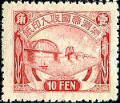 |
||||
 |
 |
|||||||
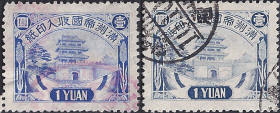 |
||||||||
| Two distinct colours Bright Blue and Dull Blue (Bright blue most common and the earlier issue) | ||||||||
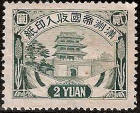 |
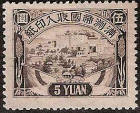 |
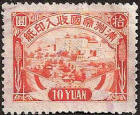 |
||||||
| Proofs | ||||||||
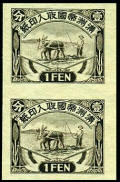
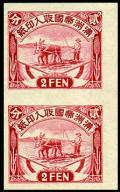

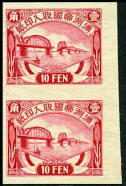 |
||||||||

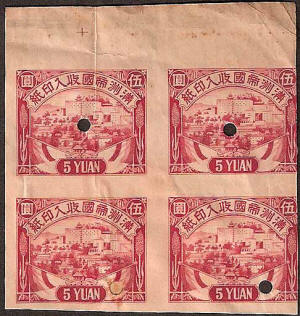
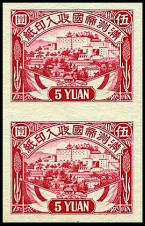 |
||||||||
|
Proofs exist of all denominations, with
or without security holes. These appear on white, un-watermarked
paper. Note the colour changes.
The above block of 4 x 5Y is part of a sheet stamped with the cancel of "Nippon-Siam Trading". This may be a specimen proof from a company in Thailand trying to win a contract to print revenue stamps on behalf of the Government of Manchukuo. |
||||||||
| Court Cancels | ||||||||
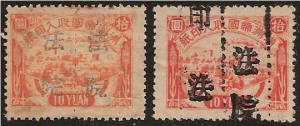 |
||||||||
|
The light orange stamp on the left is a
colour variety, both of the above stamps have cancels typical of
court use. These cancels were applied with a roller and where this
is done on a soft surface the dotted lines often perforate the
stamp. Most of the used stamps have similar overprints and this
indicates that they were used to pay court fees and fines. The above characters are 法 院 Court, 印 Printed. |
||||||||
| Passport Perfins | ||||||||
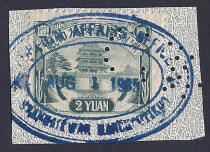 |
||||||||
| Higher value revenues are sometimes found with perfins. These perfins were used on Visas and Passports and they can be in the form of a country identifier (such as USA), or the word CANCELLED, used when a visitor exited the country. Above is a CANCELLED stamp from the "Foreign Affairs Office, Shanheikwan Manchutiku" however in this instance not all pins were able to penetrate the page. To see an example of a complete of a passport click here. | ||||||||
| Post War Usage as Insured Value Seals | ||||||||
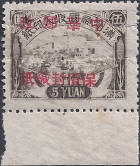 |
||||||||
| Stamps of the second revenue series can be found overprinted "中華郵政 China Postal Service 保價封缄纸 Insured Paper Seal". Note genuine stamps often have additional perforation to enable them to be used with thread used for a special insured mail envelope. To see an example of the perforation click here. | ||||||||
|
|
||||||||
|
Third Regular Issue of Manchukuo Revenue Stamps Issued 8th September 1944, the Third Regular Issue is a set of 13 values - 1 fen, 2fen, 3fen. 5fen, 10fen (1chiao), 20fen (2chiao), 50fen (5chiao), 1Yuan, 2Yuan, 5Yuan, 10Yuan, 50Yuan and 100Yuan. Designs vary, the lower values feature beans and flowers, higher values have a more stylised pattern. These are the only revenue stamps to feature the Orchid emblem of Manchukuo. The poor quality of the perforation is typical of stamps produced in Manchukuo towards the end of the war.
The upper curved panel reads
滿州帝國
Empire of Manchuria. The stamps were litho printed on watermarked (see below) "granite" paper in sheets of 100 by the Central Bank of Manchukuo Printing Department in Hsinking. Designer unknown. No records of numbers printed exist.
Perf 13½ x 13.
|
||||||||
 |
 |
 |
 |
 |
||||
| 1 fen red | 1 fen orange | 2f | 3f | 5f | ||||
 |
Purple |
 |
||||||
| 10f | 20f | 50f | ||||||
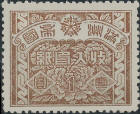 |
Purple |
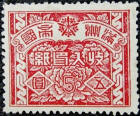 |
Orange |
Green Pin Perf |
||||
| 1Y | 2Y | 5Y | 10Y | 50Y | ||||
|
Violet Pin Perf |
||||||||
| 100Y | ||||||||
|
To see examples of these stamps in use
on original documents click
here.
|
||||||||
| Post War Usage with Chinese Republic Overprints | ||||||||
 |
 |
 |
||||||
 |
 |
 |
||||||
| c 1945/6 - The above stamps appear with a post war 中華民國 Chinese Republic overprints in red. The overprints can be applied vertically of horizontally as shown above in a pinkish-red ink. It is debatable as to whether these represent a genuine usage or were the product of an inventive post war dealer (as was common with MLO's). Parts of this set are listed both by Barefoot and Shimomura and they are also shown elsewhere so it is likely that they had some legitimate use, if only for a very short time. | ||||||||
| Post War Usage as Insured Value Seals | ||||||||
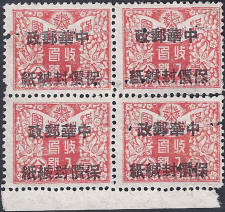
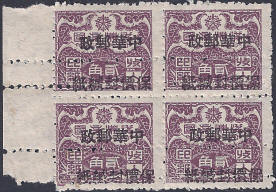 |
||||||||
| 1f Stamp Overprinted | 20f Stamp Overprinted | |||||||
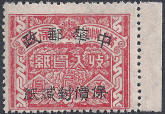 |
||||||||
| 5Y Stamp Overprinted | ||||||||
|
Stamps of the third revenue series
found
overprinted "中華郵政
China Postal
Service 保價封缄纸
Insured Paper Seal". Note genuine stamps have additional
perforation to enable them to be used with insured mail. To see an
example of the perforation click
here. After the fall of Manchukuo in 1945 many of these stamps were overprinted with a vertical chop in black reading "Republic of China" and can even be found with a Russian chop. They obviously continued in use for a time in a similar way to the Manchurian Local Overprints until new Chinese stamps were produced. Beware though, some overprints appearing recently are clearly bogus. |
||||||||
|
|
||||||||
| Postage Stamps Used as General Revenue Stamps | ||||||||
| Below are two examples of Postage Stamps used as revenue stamps to pay tax. This is extremely rare usage and one can only speculate as to how this came about, probably as a result of shortages in supply. Both of these examples are from Harbin so it is possible that this was a local custom. In Japan Postage Stamps, savings stamps and revenue stamps were often interchangeable, this was not commonly practiced in Manchukuo. | ||||||||
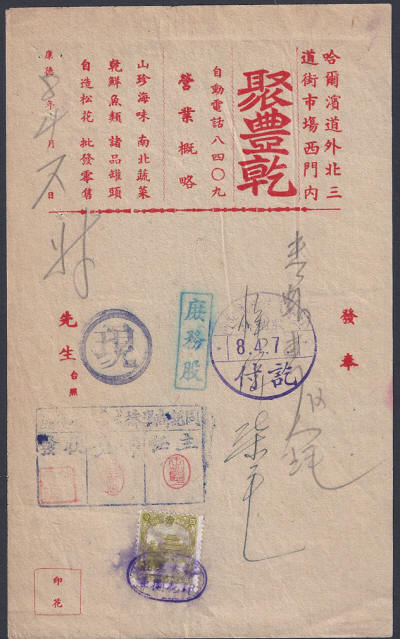 |
||||||||
|
This is a receipt dates 7th May 1940
Seems to be an
issuing-form from Harbin, possibly a grocery store. The
purple chop on the stamp, though smudged, bottom right 2
characters are for TAX-STAMP (chop) 印花图章
|
||||||||
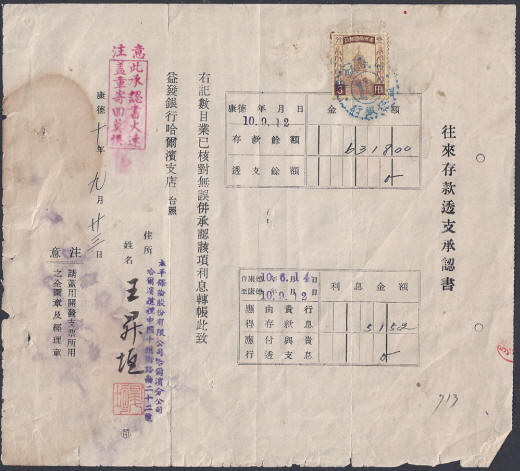 |
||||||||
| This is a receipt dates 23rd September 1943. This it is a deposit-certificate for money placed at the Yifa Bank, Harbin branch. | ||||||||
|
|
||||||||

